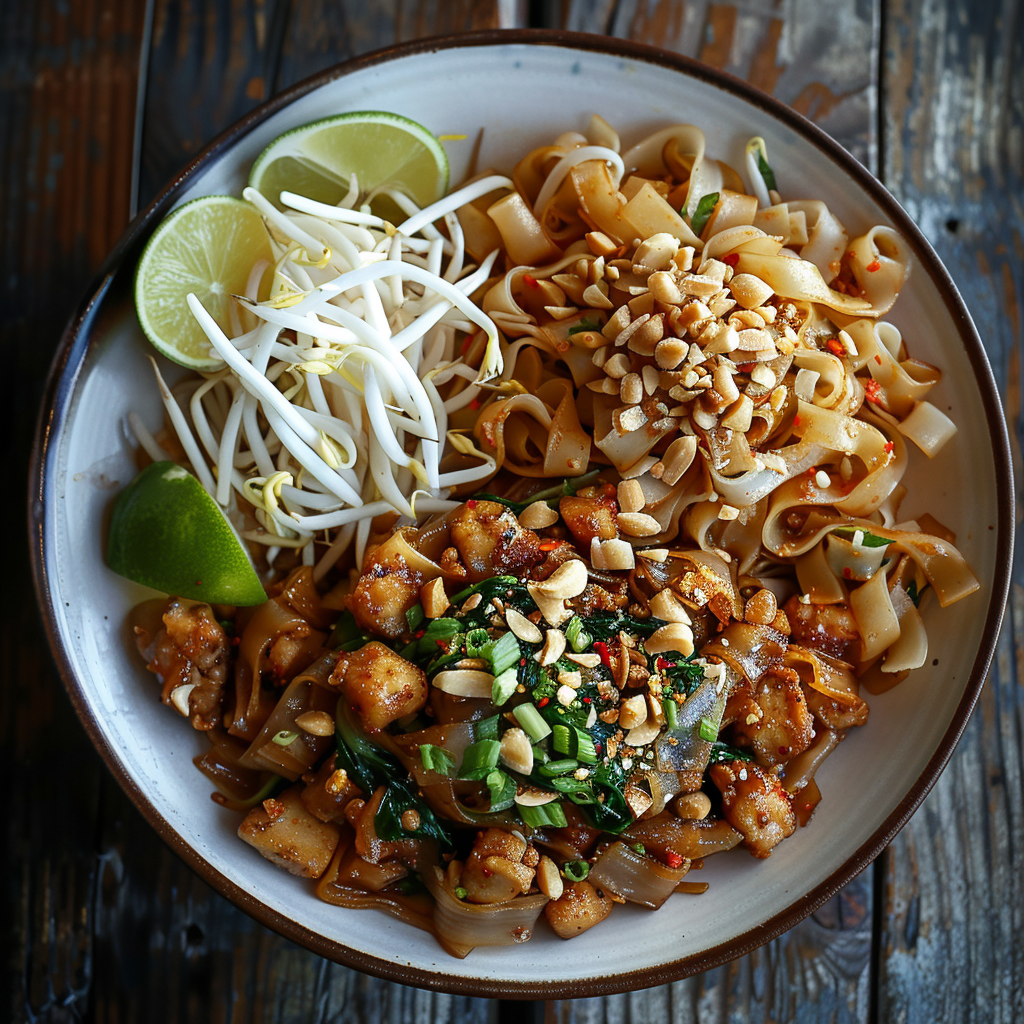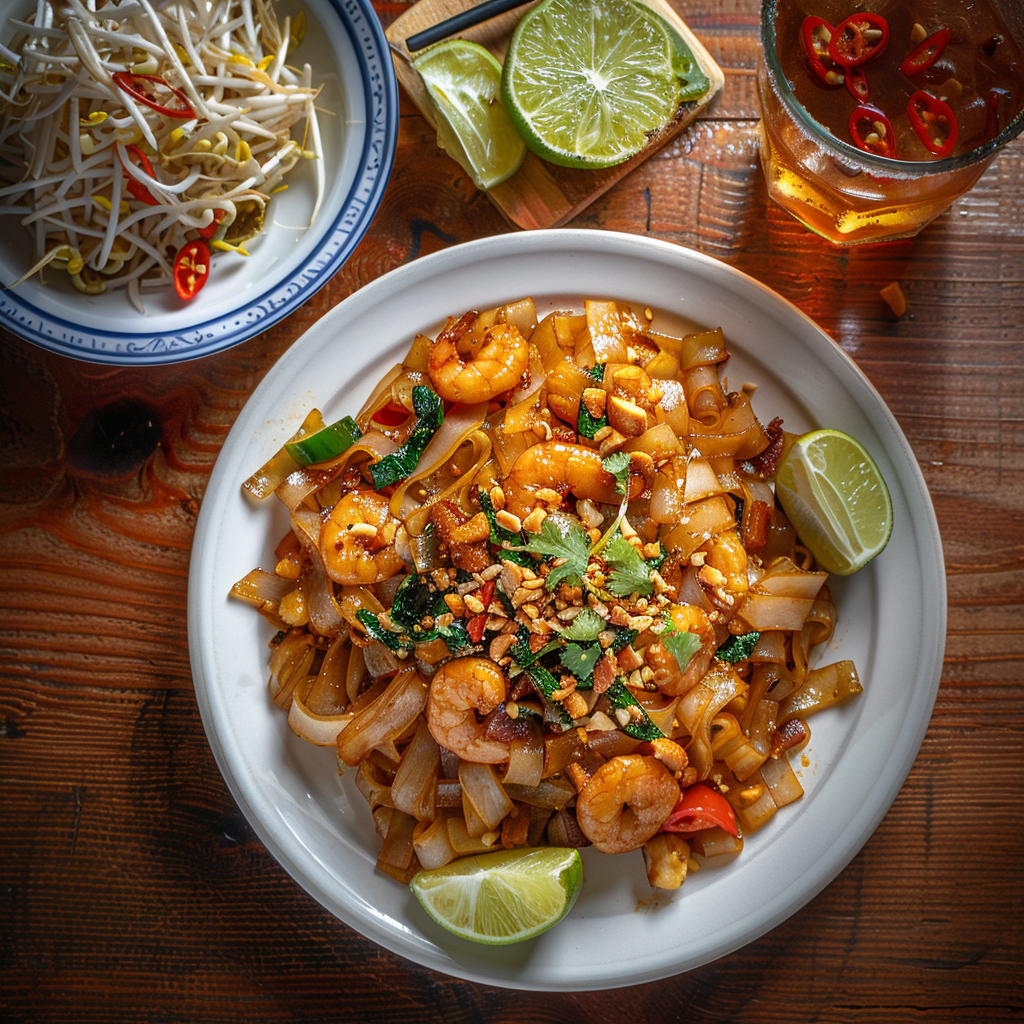Two Thai Noodles, One Big Decision
Let me tell you a little story. Last Friday night, I was craving something comforting yet exciting for dinner—something that would make my taste buds dance without breaking the bank. Enter pad see ew vs drunken noodles, two of Thailand’s most beloved noodle dishes. It was a battle in my kitchen, and honestly, both won in their own delicious ways. If you’ve ever stood in front of a Thai menu wondering which one to order, this guide is for you. Today, we’ll dive into what makes these dishes special, how they differ, and why you should try making them at home.
A Little History Never Hurt Anyone
Both pad see ew and drunken noodles (or pad kee mao) have deep roots in Thai street food culture. Pad see ew, with its wide rice noodles, soy sauce, and tender beef or chicken, has a rich umami flavor. Meanwhile, drunken noodles are spicier, bolder, and often come loaded with veggies and your protein of choice. Legend has it that drunken noodles got their name because they were originally served late at night to people who’d had a drink or two. As for pad see ew, it’s a go-to comfort food in Thailand, perfect for filling up after a long day.
Last summer, I visited Bangkok and ate my way through the city. I remember sitting on a tiny plastic stool by the roadside, slurping a plate of pad see ew so good it made me want to cry. Then, later that night, I tried drunken noodles, which were fiery enough to wake me right up. Back home, I knew I had to recreate these magic moments in my own kitchen.
Why You’ll Love These Recipes
What’s not to love? Both dishes are packed with bold flavors and textures. The chewy rice noodles soak up sauces like a dream, while fresh ingredients like garlic, chilies, and basil add pops of brightness. Plus, they’re surprisingly easy to whip up—even if you’re new to cooking Thai food. Whether you’re looking for a quick weeknight meal or a dish to impress guests, pad see ew and drunken noodles deliver every time.
When to Whip Out These Dishes
These recipes shine during casual dinners, potlucks, or even date nights. Imagine serving a steaming plate of pad see ew after a busy workday or bringing drunken noodles to a party for a spicy twist. They pair beautifully with ice-cold beers or refreshing iced tea. Trust me, once you serve these, everyone will be asking for seconds—and the recipe!
Ingredients You’ll Need
- Wide rice noodles
- Protein: Chicken, beef, shrimp, or tofu
- Garlic, minced
- Fresh Thai basil leaves
- Soy sauce (dark and light)
- Oyster sauce
- Fish sauce
- Chili peppers
- Veggies like bell peppers, broccoli, or snap peas
- Eggs
- Vegetable oil
Substitution Options
No wide rice noodles? No problem! Use thin rice noodles or even spaghetti in a pinch. Swap out proteins based on what you have—chicken thighs, flank steak, or even leftover rotisserie chicken all work wonders. For vegetarians, mushrooms or chickpeas can replace meat. And if you can’t find Thai basil, regular basil will do just fine (though Thai basil gives that authentic kick).
Step 1: Prep Your Ingredients
Start by soaking your rice noodles in warm water until they’re soft but still firm. While they soak, chop your veggies, slice your protein, and mince the garlic. This step is crucial because stir-frying happens fast, and having everything ready ensures you don’t burn anything. Pro tip: Keep your wok or skillet super hot throughout cooking—it’s key to achieving that signature smoky flavor.
Step 2: Cook the Protein
Heat some oil in your wok and toss in the protein first. Cook it quickly over high heat until it’s browned and cooked through. Remove it from the pan and set aside. This technique keeps the protein juicy and prevents overcrowding the wok later. Chef’s tip: A splash of fish sauce while cooking adds an extra layer of savory goodness.
Step 3: Stir-Fry the Veggies and Noodles
Add more oil to the wok, then throw in the garlic and chilies. Once fragrant, toss in the veggies and stir-fry until they’re vibrant and slightly softened. Now, drain the noodles and add them to the mix. Pour in your sauces—soy, oyster, and a dash of sugar—and toss everything together. Finally, return the protein to the wok and give it a final stir. The aroma alone will make your mouth water.
Step 4: Finish with Freshness
Crack an egg into the wok and scramble it right into the noodles for a creamy touch. Toss in handfuls of fresh basil leaves just before removing from heat. Their fragrance will perfume the entire dish. Serve immediately while hot and enjoy the symphony of flavors and textures.
Timing Is Everything
- Prep Time: 15 minutes
- Cooking Time: 10 minutes
- Total Time: 25 minutes
With such speedy prep and cook times, these dishes are perfect for busy evenings when you need something satisfying fast.
Chef’s Secret
Here’s a little trick: Always undercook your noodles slightly when boiling or soaking them. They’ll finish cooking in the wok, preventing them from turning mushy. Also, don’t skip the dark soy sauce—it adds depth and a gorgeous caramel color to your dish.
Did You Know?
Rice noodles are naturally gluten-free, making these dishes a great option for those avoiding wheat. Plus, studies show that Thai basil contains compounds that may help reduce inflammation. So go ahead, pile on those herbs!
Necessary Equipment
- Wok or large skillet
- Tongs or spatula for tossing
- Sharp knife and cutting board
- Bowls for prepped ingredients
How to Store Leftovers
If you end up with leftovers (unlikely, but possible), store them in an airtight container in the fridge for up to three days. Reheat gently in a skillet to restore the texture. Avoid microwaving, as it can make the noodles soggy.
For longer storage, freeze portions in zip-top bags. When reheating, let them thaw overnight in the fridge first. Pro tip: Add a splash of water or broth while reheating to keep things moist.
Remember, these dishes taste best fresh, so don’t hesitate to share them with friends or family. Sharing is caring, after all!
Tips and Advice
- Use high-quality sauces—they really make a difference.
- Don’t overcrowd the wok; cook in batches if needed.
- Adjust spice levels to suit your tolerance.
Presentation Tips
- Garnish with extra basil leaves for a pop of green.
- Serve on colorful plates to highlight the vibrant colors.
- Pair with lime wedges for a zesty finishing touch.
Healthier Alternatives
Want to lighten things up? Try these six variations:
- Zucchini Noodle Swap: Spiralized zucchini replaces rice noodles for fewer carbs.
- Tofu Power: Opt for baked tofu instead of fried for lower fat content.
- Less Sauce: Reduce the amount of soy and oyster sauce for less sodium.
- More Veggies: Bulk up the dish with spinach, kale, or bok choy.
- Egg White Only: Use only egg whites for a leaner option.
- Coconut Aminos: Substitute soy sauce with coconut aminos for a gluten-free alternative.
Mistake 1: Overcooking the Noodles
This happens when noodles sit too long in the wok or aren’t drained properly. To avoid this, keep stirring constantly and remove them from heat as soon as they’re tender. Pro tip: Test a noodle frequently to ensure it’s al dente.
Mistake 2: Skipping the Basil
Some folks think basil is optional, but it’s essential for that authentic flavor. Without it, the dish feels incomplete. Always use fresh basil for the best results.
Mistake 3: Using Low Heat
Low heat leads to soggy noodles and unevenly cooked ingredients. Crank up the heat and embrace the sizzle—it’s the secret to restaurant-quality stir-fries.
FAQs About Pad See Ew vs Drunken Noodles
What is the difference between Pad See Ew and drunken noodle?
Pad see ew uses sweeter, thicker sauces and focuses on a balance of flavors, while drunken noodles are spicier and bolder. Think sweet versus heat!
What’s healthier, Pad Thai or drunken noodle?
Drunken noodles tend to be healthier due to fewer added sugars and more veggies, though portion control matters most.
What tastes better, Pad Thai or Pad See Ew?
It depends on your mood! Pad Thai offers tangy sweetness, while pad see ew leans savory and comforting.
Why is Pad See Ew called drunken noodles?
Actually, it’s not! That nickname belongs to pad kee mao, aka drunken noodles.
What does pad thai taste like?
Pad thai tastes tangy, sweet, and nutty, thanks to tamarind paste, peanuts, and palm sugar.
Which Thai dish has the most calories?
Pad thai tends to be higher in calories due to peanuts and oils, but moderation is key.
Can I make these dishes vegan?
Absolutely! Swap meat for tofu and use vegan sauces.
What’s the best Thai dish for beginners?
Start with pad see ew—it’s mild, comforting, and universally loved.
Are drunken noodles very spicy?
Yes, they pack heat, but you can adjust the chili quantity to your liking.
Where can I buy Thai basil?
Check Asian markets or grow your own—it’s easier than you think!
Final Thoughts
Whether you choose pad see ew or drunken noodles, you’re guaranteed a flavorful adventure. These dishes remind us that food isn’t just about sustenance—it’s about connection, culture, and joy. So grab your wok, invite some friends over, and get cooking. After all, life’s too short for boring meals!

Pad See Ew vs Drunken Noodles
Ingredients
Equipment
Method
- Soak rice noodles in warm water until soft but still firm.
- Chop veggies, slice protein, and mince garlic while noodles soak.
- Heat oil in a wok and cook protein until browned, then set aside.
- Add more oil to the wok, sauté garlic and chilies until fragrant.
- Stir-fry veggies until vibrant, then drain and add noodles.
- Pour in soy sauce, oyster sauce, and a dash of sugar, tossing everything together.
- Return the cooked protein to the wok and stir well.
- Crack an egg into the wok and scramble it into the noodles.
- Add fresh basil right before serving and mix well.



